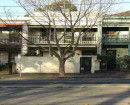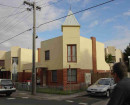Back to search results
FORMER MACARONI FACTORY
64 MAIN ROAD HEPBURN SPRINGS, HEPBURN SHIRE
FORMER MACARONI FACTORY
64 MAIN ROAD HEPBURN SPRINGS, HEPBURN SHIRE
All information on this page is maintained by Heritage Victoria.
Click below for their website and contact details.
Victorian Heritage Register
-
Add to tour
You must log in to do that.
-
Share
-
Shortlist place
You must log in to do that.
- Download report
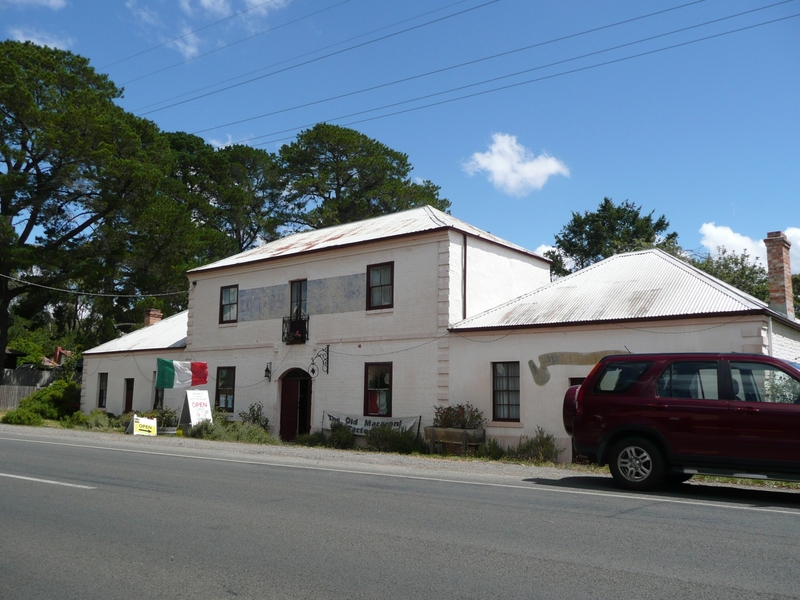
FORMER MACARONI FACTORY SOHE 2008

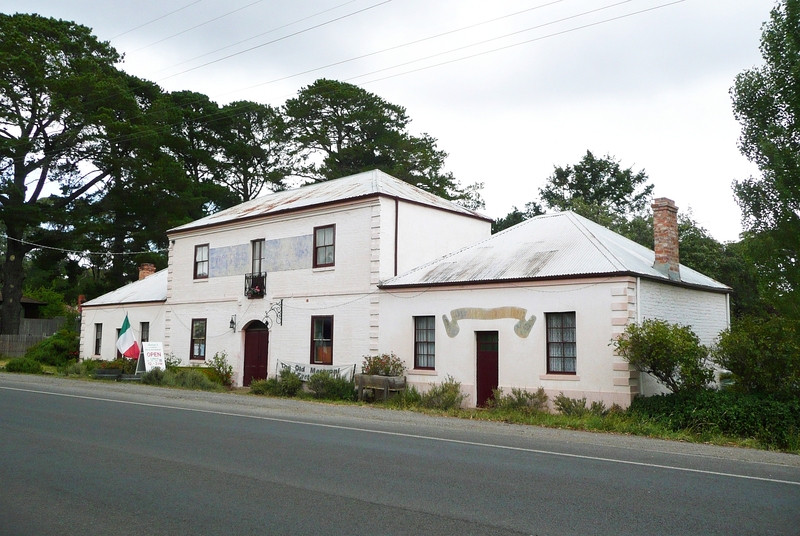
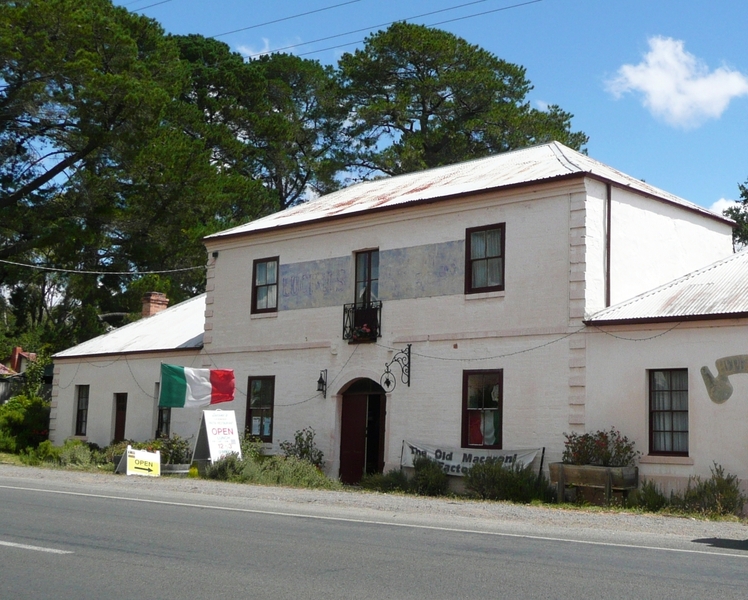
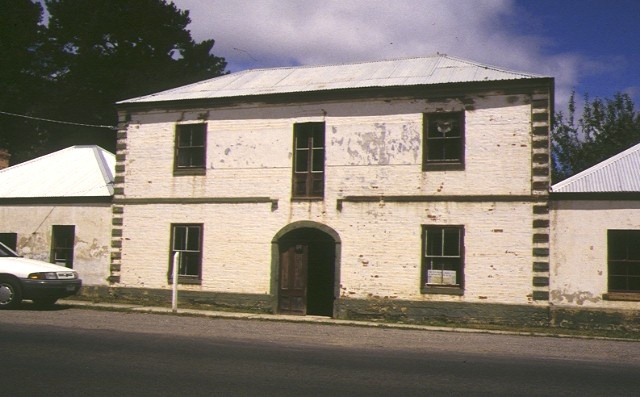
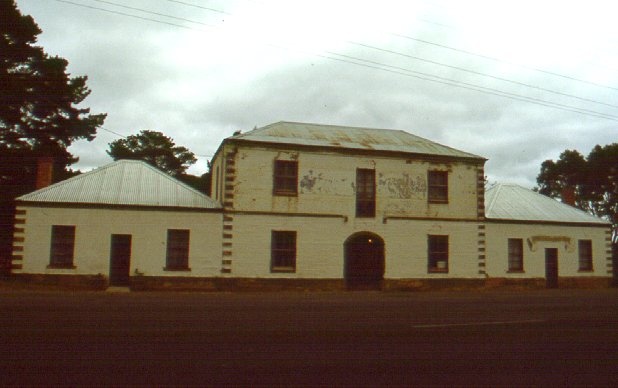
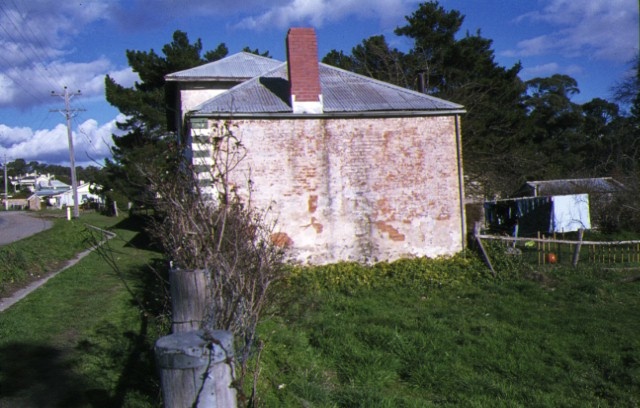
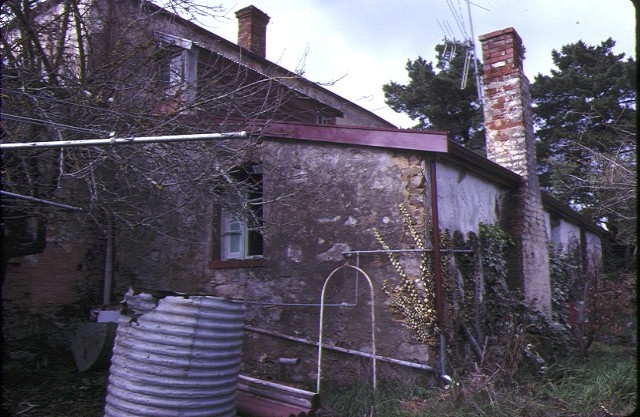


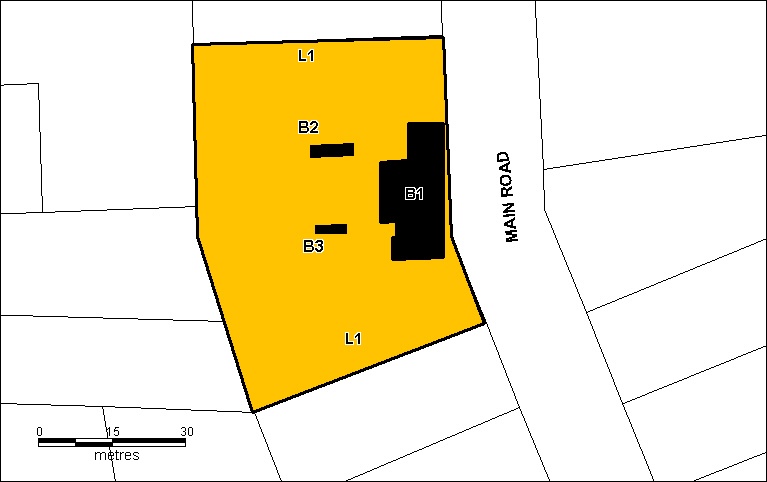
On this page:
Statement of Significance
What is significant?
The former Macaroni Factory was commenced in 1859 by brothers Giacomo and Pietro Lucini. The Lucinis were fabric merchants from Intra on Lake Maggiore in northern Italy. As supporters of Giussepe Mazzini, the Democratic Republican leader during the 1848 revolution in the Italian states, the brothers were forced to migrate as political refugees to Melbourne in the 1850s.
As well as operating as macaroni makers for a short time in Melbourne in the early 1850s, Pietro established a bakery in Spring Creek (Hepburn Springs), supplying macaroni, salami and sausages to the large Italian and Swiss population in the Hepburn-Yandoit area. Many of the Italian migrants working on the goldfields in the area were also Mazzini supporters. The Lucini family supported Italian gold prospectors by loans of money and 'grub-staking', whereby the Lucinis supplied weekly rations of bread, macaroni, salami, olive oil, tea and tobacco in exchange for a one-third share of any gold found. The Lucinis also had substantial interests in gold mines in the 1860s and bought and sold gold.
The former Macaroni Factory building was finished in 1862-64 by the addition of the flanking single storey pavilions. As well as functioning as a macaroni factory the building was the Lucini family home, and additionally between 1864 and 1870 it was licensed as the Roma Hotel. In 1880 the Lucini's won a prize for their macaroni at the Melbourne Exhibition. A hand painted sign 'Hepburn Democratic Club' on the front of the building suggests that the building operated as a focus for the local community until the late nineteenth century. The macaroni business continued until the 1930s, when the machinery was sold and the building became holiday apartments.
The building is constructed of stone and brick. The original slate roof was replaced by corrugated galvanised iron in c1930. Shingles to the pavilion roofs survive beneath later corrugated iron.
Internally the building has a comprehensive hand painted mural scheme. Executed by Giacomo Lucini in 1862-64 in a naive style, the murals cover many of the walls and ceilings. Technically the paintings imitate the surface finish of a fresco, where paint is applied to fresh plaster. The themes are secular and political, depicting different aspects of the Lucinis' lives. The largest mural is on the ceiling of the southern pavilion, depicting the flags of Italy, Switzerland, France and Britain (Australia), and six vignettes of home and family life. Stencils were used to create a repeating floral motif to the walls.
How is it significant?
The former Macaroni Factory is of historic, aesthetic and architectural significance to the State of Victoria.
Why is it significant?
The former Macaroni Factory is aesthetically significant for its interior decorative scheme. It is one of the largest and most intact domestic, secular murals in Australia. The comprehensive treatment of walls and ceilings in the naïve style is both an early and rare example in Victoria. The murals in Mintaro near Romsey and Labassa at Caulfield tell stories of the stages of the owner's lives. At Villa Alba the decoration is partly inspired by Sir Walter Scott's novel 'Rob Roy' and illustrates both old and new world nationalism. In contrast, the iconography at the former Macaroni Factory evokes both a sentimentality of a migrant family for the Old World, plus an expression of the political cause they supported in their homeland and continued to promote in Australia. Such an overt political theme expressed in a decorative scheme is very uncommon in a domestic building in Australia.
The former Macaroni Factory is historically significant as evidence of non-British European migration to the goldfields of Victoria. The Lucini family were one of those merchant families who thrived as suppliers to gold prospectors, and they were in a strong position to be commercially successful through cultural links with the Italian and Swiss miners of the 1850s, 60s and 70s.
The former Macaroni Factory is architecturally significant as an example of north Italian style building. There are a number of such houses, farms, huts and stone walls in the Daylesford-Hepburn-Yandoit area, and the former Macaroni is a substantial and early example. The exterior form and plan is noticeably Palladian in style, evidenced by a main block flanked by lower pavilions. This form is unusual for this period in Victoria.
The former Macaroni Factory was commenced in 1859 by brothers Giacomo and Pietro Lucini. The Lucinis were fabric merchants from Intra on Lake Maggiore in northern Italy. As supporters of Giussepe Mazzini, the Democratic Republican leader during the 1848 revolution in the Italian states, the brothers were forced to migrate as political refugees to Melbourne in the 1850s.
As well as operating as macaroni makers for a short time in Melbourne in the early 1850s, Pietro established a bakery in Spring Creek (Hepburn Springs), supplying macaroni, salami and sausages to the large Italian and Swiss population in the Hepburn-Yandoit area. Many of the Italian migrants working on the goldfields in the area were also Mazzini supporters. The Lucini family supported Italian gold prospectors by loans of money and 'grub-staking', whereby the Lucinis supplied weekly rations of bread, macaroni, salami, olive oil, tea and tobacco in exchange for a one-third share of any gold found. The Lucinis also had substantial interests in gold mines in the 1860s and bought and sold gold.
The former Macaroni Factory building was finished in 1862-64 by the addition of the flanking single storey pavilions. As well as functioning as a macaroni factory the building was the Lucini family home, and additionally between 1864 and 1870 it was licensed as the Roma Hotel. In 1880 the Lucini's won a prize for their macaroni at the Melbourne Exhibition. A hand painted sign 'Hepburn Democratic Club' on the front of the building suggests that the building operated as a focus for the local community until the late nineteenth century. The macaroni business continued until the 1930s, when the machinery was sold and the building became holiday apartments.
The building is constructed of stone and brick. The original slate roof was replaced by corrugated galvanised iron in c1930. Shingles to the pavilion roofs survive beneath later corrugated iron.
Internally the building has a comprehensive hand painted mural scheme. Executed by Giacomo Lucini in 1862-64 in a naive style, the murals cover many of the walls and ceilings. Technically the paintings imitate the surface finish of a fresco, where paint is applied to fresh plaster. The themes are secular and political, depicting different aspects of the Lucinis' lives. The largest mural is on the ceiling of the southern pavilion, depicting the flags of Italy, Switzerland, France and Britain (Australia), and six vignettes of home and family life. Stencils were used to create a repeating floral motif to the walls.
How is it significant?
The former Macaroni Factory is of historic, aesthetic and architectural significance to the State of Victoria.
Why is it significant?
The former Macaroni Factory is aesthetically significant for its interior decorative scheme. It is one of the largest and most intact domestic, secular murals in Australia. The comprehensive treatment of walls and ceilings in the naïve style is both an early and rare example in Victoria. The murals in Mintaro near Romsey and Labassa at Caulfield tell stories of the stages of the owner's lives. At Villa Alba the decoration is partly inspired by Sir Walter Scott's novel 'Rob Roy' and illustrates both old and new world nationalism. In contrast, the iconography at the former Macaroni Factory evokes both a sentimentality of a migrant family for the Old World, plus an expression of the political cause they supported in their homeland and continued to promote in Australia. Such an overt political theme expressed in a decorative scheme is very uncommon in a domestic building in Australia.
The former Macaroni Factory is historically significant as evidence of non-British European migration to the goldfields of Victoria. The Lucini family were one of those merchant families who thrived as suppliers to gold prospectors, and they were in a strong position to be commercially successful through cultural links with the Italian and Swiss miners of the 1850s, 60s and 70s.
The former Macaroni Factory is architecturally significant as an example of north Italian style building. There are a number of such houses, farms, huts and stone walls in the Daylesford-Hepburn-Yandoit area, and the former Macaroni is a substantial and early example. The exterior form and plan is noticeably Palladian in style, evidenced by a main block flanked by lower pavilions. This form is unusual for this period in Victoria.
Show more
Show less
-
-
FORMER MACARONI FACTORY - History
Associated People:
FORMER MACARONI FACTORY - Permit Exemptions
General Exemptions:General exemptions apply to all places and objects included in the Victorian Heritage Register (VHR). General exemptions have been designed to allow everyday activities, maintenance and changes to your property, which don’t harm its cultural heritage significance, to proceed without the need to obtain approvals under the Heritage Act 2017.Places of worship: In some circumstances, you can alter a place of worship to accommodate religious practices without a permit, but you must notify the Executive Director of Heritage Victoria before you start the works or activities at least 20 business days before the works or activities are to commence.Subdivision/consolidation: Permit exemptions exist for some subdivisions and consolidations. If the subdivision or consolidation is in accordance with a planning permit granted under Part 4 of the Planning and Environment Act 1987 and the application for the planning permit was referred to the Executive Director of Heritage Victoria as a determining referral authority, a permit is not required.Specific exemptions may also apply to your registered place or object. If applicable, these are listed below. Specific exemptions are tailored to the conservation and management needs of an individual registered place or object and set out works and activities that are exempt from the requirements of a permit. Specific exemptions prevail if they conflict with general exemptions. Find out more about heritage permit exemptions here.Specific Exemptions:General Conditions:
1. All exempted alterations are to be planned and carried out in a manner which prevents damage to the fabric of the registered place or object.
2. Should it become apparent during further inspection or the carrying out of alterations that original or previously hidden or inaccessible details of the place or object are revealed which relate to the significance of the place or object, then the exemption covering such alteration shall cease and the Executive Director shall be notified as soon as possible.
3. If there is a conservation policy and plan approved by the Executive Director, all works shall be in accordance with it.
4. Nothing in this declaration prevents the Executive Director from amending or rescinding all or any of the permit exemptions.
5. Nothing in this declaration exempts owners or their agents from the responsibility to seek relevant planning or building permits from the responsible authority where applicable.
Former Macaroni Factory
* Minor repairs and maintenance which replace like for like materials.
* Installation, removal or replacement of curtain tracks, rods, blinds and other window dressings.
* Installation, removal or replacement of hooks, nails and other devices for the hanging of interpretive materials, paintings and other wall mounted displays.
* Refurbishment of existing bathrooms, toilets and or en suites including removal, installation or replacement of sanitary fixtures and associated piping, mirrors, wall and floor coverings.
* Refurbishment of 1940s kitchen area including installation, removal or replacement of kitchen benches and fixtures including sinks, stoves, ovens, refrigerators, dishwashers etc and associated plumbing and wiring.
* Installation, removal or replacement of electrical wiring provided that all new wiring is fully concealed and any original light switches, pull cords, push buttons or power outlets are retained in-situ. Note: if wiring original to the place was carried in timber conduits then the conduits should remain in-situ.
* Installation, removal or replacement of smoke detectors.
Weatherboard laundry and wash-house and toilets
* All repairs and maintenance which replace like for like materials.FORMER MACARONI FACTORY - Permit Exemption Policy
The former Macaroni Factory has a high degree of integrity in respect of both its plan and decorative finish. Structural alterations have been minimal, and the interior murals have survived more or less intact, albeit with problems caused by damp. Ongoing conservation of these murals is essential. Exterior painted signage comprising ‘Lucini’s Macaroni Factory’ and ‘Hepburn Democratic Club’ survives but requires conservation. All these works, including ongoing plaster repair and remedial damp treatment, remain subject to permit approval by Heritage Victoria.
Some areas of the main building date from the 1940s and 1950s. The 1940s kitchen at the rear of the southern pavilion was added when the property became a caravan park. It has little significance relative to the rest of the building and changes or demolition are permit exempt.
The 1950s toilet block in the rear garden constructed of fibro-cement sheets forms part of the registration but is of contributory significance. The 1940s weatherboard laundry and wash house is more significant, being partly lined with macaroni packing case boards.
-
-
-
-
-
PARMA HOUSE
 Victorian Heritage Register H0608
Victorian Heritage Register H0608 -
HEPBURN MINERAL SPRINGS RESERVE
 Victorian Heritage Register H2098
Victorian Heritage Register H2098 -
SWIMMING POOL
 Victorian Heritage Register H1865
Victorian Heritage Register H1865
-
'Altona' Homestead (Formerly 'Laverton' Homestead) and Logan Reserve
 Hobsons Bay City
Hobsons Bay City
-
-







